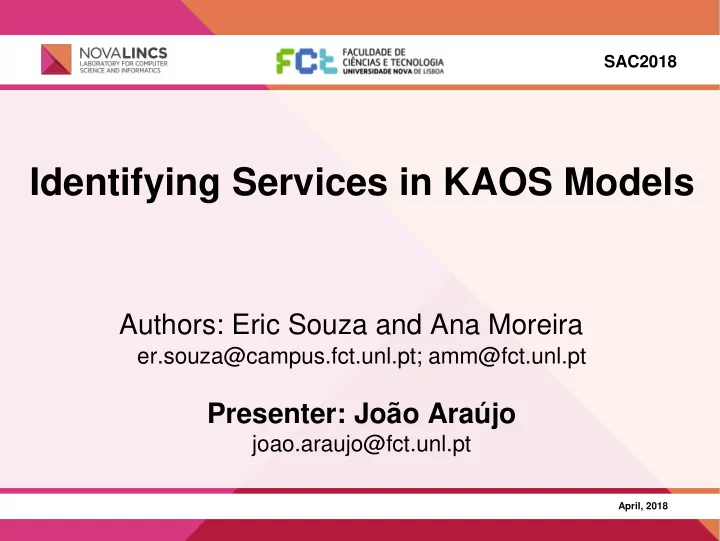

SAC2018 Identifying Services in KAOS Models Authors: Eric Souza and Ana Moreira er.souza@campus.fct.unl.pt; amm@fct.unl.pt Presenter: João Araújo joao.araujo@fct.unl.pt April, 2018
SAC2018 Context • Deploying Service-Oriented Architecture (SOA) in an organization requires that the services are aligned with the business concerns [1, 2] [1] Azevedo L. et al.. A method for bridging the gap between business process models and services. iSys-Revista Brasileira de Sistemas de Informação 6(1), 62 – 8, (2014) [2] Hans Weigand et al.. Value-based service modeling and design: Toward a unified view of services. In International Conference on Advanced Information Systems Engineering . Sprin- ger, Berlin, Heidelberg. 2
SAC2018 Context • Lack of consensus on how service development life cycle should be conducted [1] Existing service-oriented works do not offer detailed • and systematic methods for business analysis and services identification [2] [1] Q. Gu and P. Lago. A stakeholder-driven service life cycle model for SOA. In 2nd international workshop on Service oriented software engineering @ 6th ESEC/FSE joint meeting. ACM, 1 – 7 (2007) [2] T. Kohlborn et al.. Identification and analysis of business and software services at a consolidated approach. IEEE Transactions on Services Computing 2 (1), 50 – 64 (2009) 3
SAC2018 Problem • Previously, we demonstrate how to generate goal- models aligned with business models [1, 2] • Existing service-oriented works propose principles or guidelines that are very difficult to follow in practice due to lack of a systematic process [3] Business SOA Requirements Modeling Modeling Modeling [1] Souza et al., Aligning Business Models with Requirements Models. In Information Systems. 14th EMCIS 2017, LNBIP Vol. 299. Springer, 545 – 558. (2017) [2] Souza, E. et al., An approach to align business and IT perspectives during the SOA services identification. In Computational Science and Its Applications 2017, 3-6 (2017) [3] Azevedo L. et al., A method for bridging the gap between business process models and services. iSys-Revista Brasileira de Sistemas de Informac̨ā o 6 (1), 62 – 98 (2014) 4
SAC2018 Research Question How to take a systematic approach to model SOA applications using goal models? 5
SAC2018 Background • SOA is an evolution of component-based development where services are the main building component [1, 2] • Services are typically specified using SOAML [1] T. Erl. Service-oriented architecture: concepts, technology, and design. Pearson Education, Inc, Indiana, USA. (2005) [2] Valipour et al., A brief survey of software architecture concepts and service oriented architecture. 2nd IEEE International Conference on Computer Science and Information Technology, 34-38 ( 2009) 6
SAC2018 Background • Goal-oriented requirements engineering uses goals to elicit, elaborate, structure, specify, analyze, negotiate, document, and modify requirements [1] • KAOS has been one of the most cited methods in the literature [2] [1] A. van Lamsweerde. Goal-oriented requirements engineering: a guided tour. Requirements Engineering conference (RE), 2001 [2] F. Wanderley and J. Araû jo. Generating goal-oriented models from creative requirements using model driven engineering. MoDRE ’ 13 (2013) 7
SAC2018 KAOS4Services 8
SAC2018 Create KAOS model 9
SAC2018 • System requirements are decomposed into human-intensive operations (executed by people), and system-intensive operations (requiring a number of computational transactions with minimal or no human intervention) • Candidate services are identified from system-intensive operations, and are ordered according to the designers’ order given to operations 10
SAC2018 Decompose requirements 11
SAC2018 Generate business process 12
SAC2018 Generate business process 13
SAC2018 Generate business process 14
SAC2018 Generate business process 15
SAC2018 Generate business process 16
SAC2018 • The execution of this non-mandatory activity depends on the level of detail the service designer wants • The more detailed the business process is, the more detailed the service specification will be 17
SAC2018 Identify candidate services 18
SAC2018 Identify candidate services 19
SAC2018 Identify candidate services 20
SAC2018 Identify candidate services 21
SAC2018 Identify candidate services 22
SAC2018 • H11: The sum of goals the candidate service needs to achieve indicates its likelihood of being reused • H12: The higher the number of dependencies to a candidate service, the higher the probability of being implemented • H13: Candidate services with a single operation (orphan operation) can be aggregated into another candidate service 23
SAC2018 Generate service specification H14: A candidate service is mapped into a SOAML service contract. H14 24
SAC2018 Generate service specification H15: KAOS agents are mapped into SOAML participants. H15 25
SAC2018 Evaluation • Industrial online auction system, from a Brazilian gas station chain fidelity program 26
SAC2018 Results • 11 candidate services identified • After analysis, 8 services to be designed • Heuristics to consolidate candidate services have been valuable, but further research is needed to decrease the subjectivity of the analysis • A SOAML specification was generated based on the 8 identified services 27
SAC2018 Conclusion • KAOS4Services is a systematic approach to modeling SOA applications using goal-models • KAOS4Services offers a set of heuristics to identify candidate services from KAOS • KAOS4Services applied to a case study based on a real- project of an on-line auction system, guiding the identification of a set of SOA services • Current and future work includes tool support using DSL techniques and exploring the satisfaction of NFRs at the architectural level 28
SAC2018 Identifying Services in KAOS Models Authors: Eric Souza and Ana Moreira er.souza@campus.fct.unl.pt amm@fct.unl.pt Presenter: João Araújo joao.araujo@fct.unl.pt Abril, 2018
Recommend
More recommend